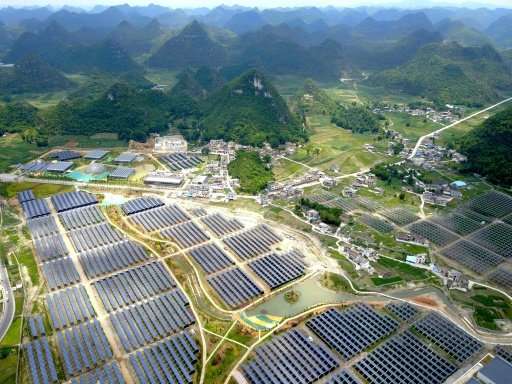Sunny future for renewables thanks to China: IEA

Solar energy is to lead the race to new power generation over the coming decades, thanks in large part to China and India, the International Energy Agency said Tuesday.
The IEA's annual World Energy Outlook report said that, over the next quarter century, the world's growing energy needs will be met first by renewables, while there are likely to be fewer new plants burning dirty coal.
With UN climate talks underway in Bonn, Germany, the IEA report brings only partially good news regarding the efforts to restrain carbon emissions and limit global warming.
Demand for oil is still expected to grow, despite the rapid arrival of electric vehicles, the IEA said.
And work needs be done to reduce output of methane from the drilling of natural gas, which is expected to become a more popular fuel.
The IEA sees the brightest future for solar.
"Solar is forging ahead in global power markets as it becomes the cheapest source of electricity generation in many places, including China and India," said Fatih Birol, the IEA's executive director.
The IEA believes solar photovoltaic cells will lead capacity additions, pushed by deployment in China and India.
However, wind is likely to sweep into the lead in the European Union, becoming the main source of electricity in the bloc soon after 2030.
"Rapid deployment of solar photovoltaics, led by China and India, helps solar become the largest source of low-carbon capacity by 2040, by which time the share of all renewables in total power generation reaches 40 percent," the IEA said.
The report also notes that "a strong emphasis on cleaner energy technologies, in large part to address poor air quality, is catapulting China to a position as a world leader in wind, solar, nuclear and electric vehicles."
The size of the Chinese economy, and its increasing share of the global energy market, mean that Beijing's choices will play a huge role in determining global trends.
The IEA also developed a scenario to achieve the goals of climate stabilisation, cleaner air and universal access to modern energy.
Low-carbon energy sources would have to double to 40 percent of the energy mix in 2040, with a quick drop in coal demand and a peak in oil use.
Not only would electric cars enter the mainstream, but stringent efficiency measures would have to be adopted for other vehicles, including trucks.
Germany, which is hosting the UN climate talks, demonstrates the difficulties of achieving such an outcome faces, as the country will remain dependent on coal as it pushes for a quick phase-out of nuclear for electricity production.
© 2017 AFP





















